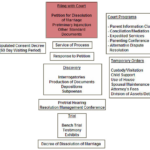 “`html
“`html
Safeguarding Retirement Savings in Arizona Divorce: The Crucial Role of QDROs
Divorce is often an emotionally taxing and financially intricate process, especially when it involves the division of tangible and intangible assets amassed over the course of a marriage. Among these assets, retirement savings and pensions frequently stand out due to their substantial value and critical role in ensuring future financial security. Within Arizona’s legal framework, set against the backdrop of community property laws, the Qualified Domestic Relations Order (QDRO) emerges as an essential tool for the equitable division of such assets. This opinion editorial delves into the various facets of QDROs, emphasizing their importance in protecting retirement savings during an Arizona divorce.
Understanding QDROs: A Legal Safeguard for Retirement Accounts
A Qualified Domestic Relations Order (QDRO) is an integral legal document necessary for the division of specific types of retirement accounts, such as 401(k)s and pensions, during a divorce. Under family law, the QDRO acknowledges the entitlement of an alternate payee—typically a spouse—to receive a designated share of the retirement benefits accumulated by the other spouse. The necessity for a QDRO arises from its compliance with the Employee Retirement Income Security Act (ERISA), ensuring that the division adheres to both federal regulations and Arizona’s community property laws.
Distinct Characteristics of QDROs
Importantly, QDROs pertain to employer-sponsored retirement plans and do not apply to Individual Retirement Accounts (IRAs), which follow distinct regulatory guidelines. Another critical aspect of QDROs is their role in averting tax penalties that might occur from improper handling or premature withdrawal of funds during property division. Thus, understanding the QDRO’s function becomes pivotal in safeguarding substantial retirement savings during divorce proceedings.
The Importance of QDROs in Arizona’s Community Property Landscape
Arizona operates under community property law, which stipulates that all marital assets, including retirement accounts, must be equitably divided between parties in a divorce. This legal mandate extends to retirement plans and pensions accrued during the marriage. In this context, a QDRO provides not just a legal avenue for fair distribution, but also protects the rights and financial interests of both parties.
Ensuring Legal and Tax Compliance
A QDRO serves as a definitive legal directive that delineates the division of retirement benefits, thus preventing potential disputes and financial penalties. Moreover, it ensures tax efficiency, as dividing retirement accounts in the absence of a QDRO could culminate in prohibitive tax implications, notably in a community property state like Arizona.
The Process of Securing a QDRO
The acquisition of a QDRO mandates meticulous planning and specialized legal expertise. This process, essential for the proper division of retirement assets, generally unfolds in several critical steps:
Step 1: Drafting the QDRO
The initial phase requires collaborating with a QDRO expert to formulate a comprehensive document that specifies the division of retirement assets. This document must conform to all pertinent legal standards and incorporate specific details about the retirement accounts in question.
Step 2: Securing Plan Administrator Approval
Once drafted, the QDRO is submitted to the retirement plan’s administrator, who reviews the document to ensure it meets the plan’s unique requirements. Obtaining this approval is imperative before proceeding to court submission.
Step 3: Court Approval and Implementation
Upon receiving the plan administrator’s sanction, the QDRO is presented to the court for approval. Subsequent to the judge’s endorsement, the QDRO becomes a conclusive court order, mandating the division of the retirement fund as stipulated. Thereafter, the plan administrator implements the division as outlined in the decree.
Common Pitfalls in Dividing Retirement Accounts
Despite its critical importance, dividing retirement accounts during divorce is fraught with potential errors that may bear long-term financial consequences. Here are some of the common pitfalls:
Forgetting to Secure a QDRO
Neglecting to incorporate a QDRO in the divorce settlement can result in improper division of retirement accounts, with severe financial repercussions for the spouse entitled to a portion of those funds.
Ignoring Plan-Specific Requirements
Each retirement plan has distinct rules governing QDROs. Overlooking these prerequisites can cause delays or even invalidation of the QDRO.
Overlooking Tax Implications
The division of retirement accounts without a thorough understanding of tax outcomes can erode the accumulated asset value. It’s crucial to be mindful of these tax consequences to maximize asset retention.
Misinterpretation of Community vs. Separate Property
Not all retirement savings qualify as community property; certain portions generated before marriage could be considered separate property. Proper assessment by a legal expert can prevent inaccurate property classification.
Frequently Asked Questions About QDROs
It’s common to encounter questions regarding QDROs during divorce proceedings, which highlights the importance of obtaining accurate legal guidance. Here are a few frequently asked questions:
What is a QDRO?
A QDRO, or Qualified Domestic Relations Order, is a court-mandated order that facilitates the division of retirement benefits between spouses in a divorce, particularly applicable to employer-sponsored plans.
Why is a QDRO essential in Arizona?
Arizona’s community property laws necessitate the fair division of marital assets, including retirement accounts, in a divorce. A QDRO ensures that such division is both legally recognized and tax-efficient.
Can IRAs be divided via a QDRO?
No, IRAs are governed by separate rules and are excluded from QDRO use. They require alternative procedures for division as instructed in the divorce decree.
What is the expected duration for obtaining a QDRO?
The length of the QDRO process varies, typically ranging from several weeks to months, contingent on the complexity of the retirement plan and the responsiveness of the plan administrator.
Conclusion: Ensuring a Secure Financial Future
Protecting retirement savings in a divorce is paramount to securing one’s financial future. At De Novo Law, our adept legal paraprofessionals possess in-depth knowledge of the complexities involved in the division of retirement accounts, ensuring accurate QDRO preparation. With professional guidance, you’re more likely to traverse the intricate legal landscape confidently and maintain financial security post-divorce. Should you require assistance, do not hesitate to contact us at (480) 660-4414 or visit our website to learn more about safeguarding your retirement assets throughout the divorce process.
“`
Read more about this topic at https://www.denovolawaz.com/protecting-retirement-savings-divorce/
Related articles you might like
Retirement topics – Divorce | Internal Revenue Service
Dividing Retirement Benefits at Divorce

